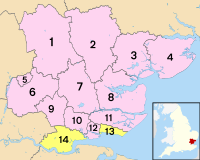Essex | |
|---|---|
Upper: the Hythe, Maldon
Lower: Cater House in Chelmsford (left); and the former Sun Inn, Saffron Walden, displaying pargeting (right) | |
 Ceremonial Essex within England | |
| Coordinates: 51°45′N 0°35′E / 51.750°N 0.583°E | |
| Sovereign state | United Kingdom |
| Constituent country | England |
| Region | East |
| Established | Ancient |
| Time zone | UTC+0 (GMT) |
| • Summer (DST) | UTC+1 (BST) |
| UK Parliament | 18 Members of Parliament |
| Police | Essex Police |
| Largest city | Southend-on-Sea |
| Ceremonial county | |
| Lord Lieutenant | Jennifer Tolhurst[1] |
| Area | 3,664 km2 (1,415 sq mi) |
| • Rank | 11th of 48 |
| Population (2022)[2] | 1,877,301 |
| • Rank | 6th of 48 |
| Density | 512/km2 (1,330/sq mi) |
| Ethnicity |
|
| Non-metropolitan county | |
| County council | Essex County Council |
| Control | Conservative |
| Admin HQ | Chelmsford |
| Area | 3,458 km2 (1,335 sq mi) |
| • Rank | 7th of 21 |
| Population (2022)[3] | 1,519,509 |
| • Rank | 2nd of 21 |
| Density | 439/km2 (1,140/sq mi) |
| ISO 3166-2 | GB-ESS |
| GSS code | E10000012 |
| ITL | UKH33 |
| Website | essex |
| Unitary authorities | |
| Councils | Southend-on-Sea City Council Thurrock Council |
| Districts | |
 Districts of Essex Unitary County council area | |
| Districts | |
Essex (/ˈɛsɪks/ ESS-iks) is a ceremonial county in the East of England, and one of the home counties. It is bordered by Cambridgeshire and Suffolk to the north, the North Sea to the east, Kent across the Thames Estuary to the south, Greater London to the south-west, and Hertfordshire to the west. The largest settlement is Southend-on-Sea, and the county town is Chelmsford.
The county has an area of 3,670 km2 (1,420 sq mi) and a population of 1,832,751. After Southend-on-Sea (182,305), the largest settlements are Colchester (130,245), Basildon (115,955) and Chelmsford (110,625).[4] The south of the county is very densely populated, and the remainder, besides Colchester and Chelmsford, is largely rural. For local government purposes Essex comprises a non-metropolitan county, with twelve districts, and two unitary authority areas: Thurrock and Southend-on-Sea. The districts of Chelmsford, Colchester and Southend have city status. The county historically included north-east Greater London, the River Lea forming its western border.
Essex is a low-lying county with a flat coastline. It contains pockets of ancient woodland, including Epping Forest in the south-west, and in the north-east shares Dedham Vale area of outstanding natural beauty with Suffolk. The coast is one of the longest of any English county, at 562 miles (905 km). It is deeply indented by estuaries, the largest being those of the Stour, which forms the Suffolk border, the Colne, Blackwater, Crouch, and the Thames in the south. Parts of the coast are wetland and salt marsh, including a large expanse at Hamford Water, and it contains several large beaches.[5][6]
What is now Essex was occupied by the Trinovantes tribe during the Iron Age. They established a settlement at Colchester, which is the oldest recorded town in Britain. The town was conquered by the Romans but subsequently sacked by the Trinovantes during the Boudican revolt. In the Early Middle Ages the region was invaded by the Saxons, who formed the Kingdom of Essex; they were followed by the Vikings, who after winning the Battle of Maldon were able to extract the first Danegeld from King Æthelred. After the Norman Conquest much of the county became a royal forest, and in 1381 the populace of the county were heavily involved in the Peasants' Revolt. The subsequent centuries were more settled, and the county's economy became increasingly tied to that of London; in the nineteenth century the railways allowed coastal resorts such as Clacton-on-Sea to develop and the Port of London to shift downriver to Tilbury. Subsequent development has included the new towns of Basildon and Harlow, the development of the Harwich International Port, and petroleum industry.[5]
- ^ "Lord-Lieutenant of Essex: Jennifer Tolhurst". GOV.UK. Retrieved 13 April 2020.
- ^ "Mid-2022 population estimates by Lieutenancy areas (as at 1997) for England and Wales". Office for National Statistics. 24 June 2024. Retrieved 26 June 2024.
- ^ "Mid-Year Population Estimates, UK, June 2022". Office for National Statistics. 26 March 2024. Retrieved 3 May 2024.
- ^ "Towns and cities, characteristics of built-up areas, England and Wales". Office for National Statistics. Retrieved 10 October 2023.
- ^ a b "Essex | History, Population, & Facts". Britannica. Retrieved 6 July 2023.
- ^ "Protecting the environment: The Essex coast | Essex County Council". www.essex.gov.uk. Retrieved 6 July 2023.


